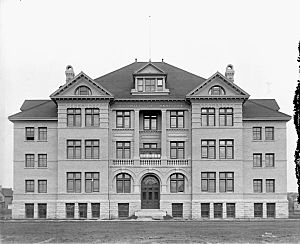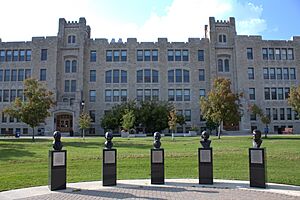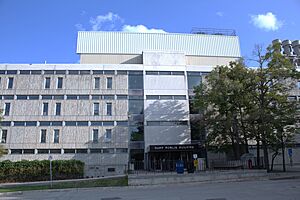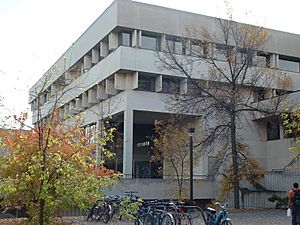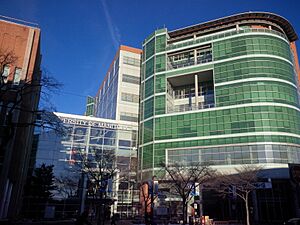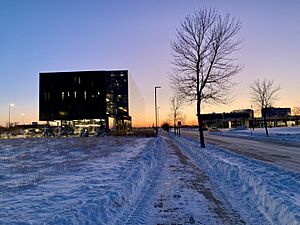University of Manitoba facts for kids
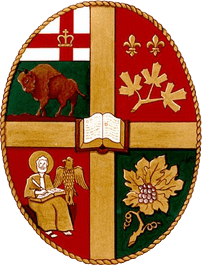 |
|
| Latin: Universitas Manitobanensis | |
| Motto | Floreat (Latin) |
|---|---|
|
Motto in English
|
Flourish (or Prosper) |
| Type | Public |
| Established | 1877 |
|
Academic affiliations
|
Campus Manitoba, CARL, CVU, U15, Universities Canada |
| Endowment | $878 million |
| Chancellor | David Angus |
| President | Michael Benarroch |
|
Academic staff
|
5,252 |
|
Administrative staff
|
3,838 |
| Students | 30,370 |
| Undergraduates | 26,660 |
| Postgraduates | 3,710 |
| Location |
,
Canada
|
| Campus | Urban, 691 acres (280 ha), Fort Garry Campus |
| Colours | Brown and gold |
| Nickname | Bisons |
|
Sporting affiliations
|
U Sports – CWUAA |
| Mascot | Billy the Bison |
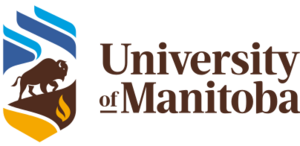 |
|
The University of Manitoba (often called U of M or UM) is a big public research university located in Winnipeg, Manitoba, Canada. It was started in 1877, making it the very first university in Western Canada. It's the largest university in Manitoba, both by the number of students and the size of its campus.
The main campus is in the Fort Garry area of Winnipeg. There are also other campuses around the city, like the Bannatyne Campus and the Université de Saint-Boniface, which teaches in French.
Scientists at the University of Manitoba helped create canola oil in the 1970s. Many famous people have studied here, including winners of the Nobel Prize and Academy Awards, and even Olympic medalists. As of 2019, the university had 99 Rhodes Scholarship winners, which is more than any other university in western Canada.
The University of Manitoba is part of the U15 group, which includes Canada's top research universities. Its sports teams, called the Manitoba Bisons, compete in U Sports.
Contents
History of the University
How the University Started
The University of Manitoba was officially created on February 28, 1877. It was founded by Alexander Morris and became the first place for higher education in western Canada.
The first leader of the university, called the Chancellor, was Robert Machray (from 1877 to 1904). The first Vice-Chancellor was Joseph Royal, who helped create the law that started the university.
Early Colleges Joining the University
When the university first opened on June 20, 1877, it was a group of three existing colleges. These colleges were Collège universitaire de Saint-Boniface (Catholic), St John's College (Anglican), and Manitoba College (Presbyterian). The university would give degrees to students who graduated from these colleges.
Over the years, more colleges joined. In 1882, the Manitoba Medical College became part of the university. Then, in 1888, Wesley College (Methodist) also joined.
In 1900, the university started teaching its own classes, not just giving degrees for other colleges. Many other colleges also became connected to the university, including:
- Manitoba College of Pharmacy (1902)
- Manitoba Agricultural College (1906)
- St. Paul's College (1931)
- Brandon College (1938)
- St. Andrew's College (1981)
Some of these colleges later became their own universities. For example, in 1967, United College became the University of Winnipeg, and Brandon College became Brandon University. However, Collège universitaire de St. Boniface, St. John's, St. Paul's, and St. Andrew's College are still connected to the University of Manitoba today.
Growing and Developing
The university held its first exams on May 27, 1878, with seven students. Two years later, in 1880, the University of Manitoba gave its first degree to Reginald William Gunn, a Métis student.
In 1886, the first woman student, Jessie Holmes, was admitted. She also became the university's first female graduate in 1889.
In the early 1900s, the university started offering more types of professional education. It also began to focus on research, like in Germany and America.
The first building just for teaching science was built in 1901 in downtown Winnipeg. The first dedicated teachers were hired in 1904 to teach science. In 1908, the university started its library.
The university decided to move its main campus to Fort Garry. This was to be close to the Manitoba Agricultural College. The first buildings there were finished in 1912. The university officially moved to this new site in 1913.
University During World War I
Many students from the university went to fight in the First World War. The university also helped train soldiers. In 1915, a special battalion of university students was formed.
In 1914, the Manitoba Law School was started. In 1919, the university also opened the first school of architecture in western Canada.
During the war, fewer students attended the university because many joined the military. After the war ended in 1918, 1160 students and 14 staff members had joined the military. Sadly, 123 of them died.
After World War I
After the war, many more students enrolled. In 1919, the University of Manitoba Students' Union was created. The University of Manitoba Alumni Association, for former students, was formed in 1921.
By 1920, the university was the largest in the Canadian Prairies and the fifth largest in Canada. It had many different areas of study, like Arts, Science, Law, and Medicine.
In the 1930s, the university moved its main offices to the Fort Garry campus. The Arts Building was finished there in 1931. The Faculty of Education was started in 1934.
University During World War II
The Second World War also had a big impact. From 1940 to 1941, the Canadian Army used the student residences. Many male students had to take military training. Women students also took courses to help with the war effort, like learning to be auto mechanics.
In 1943, the university started giving out Bachelor of Science degrees in Pharmacy. The School of Social Work was also created around this time. After the war, in 1946, many war veterans enrolled, and the number of students grew a lot.
Later Years and Important Changes
In 1963, the University College was completed. In 1966, the Manitoba Law School became a full part of the university.
In 1967, two colleges that were part of the University of Manitoba became their own universities: the University of Winnipeg and Brandon University.
In 1970, the Faculty of Arts and Science split into two separate groups: the Faculty of Arts and the Faculty of Science.
Recent History and Achievements
St. Boniface College and St. John's College are still part of the University of Manitoba today. St. Boniface College is the only one that teaches completely in French.
In 1993/94, the University of Manitoba was the first university in Canada to offer a master's degree in interior design.
In 1999, the university launched Smartpark, a special area for research and technology on the Fort Garry Campus.
In 2002, Canada Post even made a stamp to celebrate the University of Manitoba's 125th birthday!
In October 2019, the university created a new leadership role called "Vice-President (Indigenous)". This person helps lead programs and research focused on Indigenous peoples.
University Campuses
Fort Garry Campus
The main campus, called the Fort Garry campus, is located on the Red River in south Winnipeg. It has over 60 main buildings for teaching and research, covering a huge area of land. These buildings include classrooms, labs, offices, and student residences.
| Administration Building | |
|---|---|
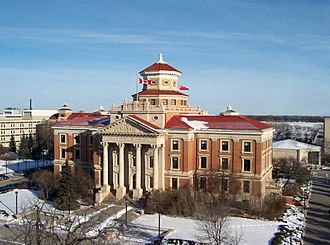 |
|
| Former names | Manitoba Agricultural College building |
| General information | |
| Architectural style | Neoclassical |
| Address | 66 Chancellors Circle, Winnipeg, MB |
| Coordinates | 49°48′35″N 97°07′58″W / 49.80962°N 97.13270°W |
| Construction started | 1911 |
| Construction stopped | 1913 |
| Design and construction | |
| Architect | Samuel Hooper and Victor Horwood |
| Designations | |
| Municipally Designated Site | |
| Designation | Winnipeg Landmark Heritage Structure |
| Recognized | February 2019 |
| Recognition authority | City of Winnipeg |
In 2013, the university held a competition to plan how to make the Fort Garry Campus even better. The goal was to improve the campus experience and guide how new buildings and transportation would be added.
Other Campuses and Locations
The William Norrie Centre is another campus for the "Inner City Social Work Program." This program helps low-income mature students (21 or older) in Winnipeg who want to study social work. The university also has a social work program in Thompson, Manitoba.
The James W. Burns Executive Education Centre is in downtown Winnipeg. It offers special training programs for professionals and leaders. This building is a provincial heritage site.
Agricultural Research Sites
The Glenlea Research Station is a farm where scientists study animals and crops. It's located south of the Fort Garry campus, near Glenlea, Manitoba. It opened in 1966.
At the Glenlea Research Station, you can find the Bruce D. Campbell Farm and Food Discovery Centre. This is a fun place where visitors can learn how food is made in Canada through hands-on activities.
The Ian N. Morrison Research Farm is another farm research facility. It's located in Carman, Manitoba, and helps with teaching and research in plant science.
Health Sciences Campus
The University of Manitoba Bannatyne Campus is a group of ten buildings in central Winnipeg. This campus is where the university's health sciences programs are located. It's connected to Winnipeg's Health Sciences Centre (HSC).
The Rady Faculty of Health Sciences brings together many health education areas. This includes the Max Rady College of Medicine, the Dr. Gerald Niznick College of Dentistry, and the College of Pharmacy.
At this campus, there's a memorial dedicated to the medical students and graduates who died serving in wars.
The Brodie Centre is the main building on the Bannatyne campus. It connects many health education facilities, including the library and fitness centre.
The College of Pharmacy moved to the Bannatyne campus in 2008 when the Apotex Centre opened. The Dr. Gerald Niznick College of Dentistry is also located here.
Max Rady College of Medicine
The Max Rady College of Medicine has 27 different departments. These departments are involved in teaching, research, and helping patients. They work closely with the Health Sciences Centre and other health facilities in Winnipeg.
University Research
The University of Manitoba is known for its strong research programs. It does more research each year than any other university in the region. Its research has led to important discoveries, like the creation of canola oil and a treatment for Rh hemolytic disease.
The university is also a leader in Intelligent Sensing for Innovative Structures (ISIS) Canada. This group works on better ways to build and monitor civil structures.
The Centre for Defence and Security Studies at the university helps people learn about defence and security issues in Canada.
Smartpark Research and Technology Park
Smartpark Research and Technology Park (or Smartpark) is a special area near the Fort Garry campus. It helps connect university research with businesses and industries. It covers 100 acres and has several buildings where over 30 research and development groups work together with the university.
Smartpark is the main research park in Manitoba. It started in 1999 and opened its first building in 2002. Today, it has at least 9 buildings.
Companies at Smartpark work on many different research areas, including:
- Information and communications technology
- Engineering and advanced materials
- Health and biotechnology
- Agricultural and nutritional science
Currently, Smartpark has 18 companies that employ 1,200 people. Many of these are students or graduates from the university.
Academics and Programs
| University rankings | |
|---|---|
| Global rankings | |
| ARWU World | 201–300 |
| QS World | 661–670 |
| Times World | 401–500 |
| U.S News & World Report Global | 417 |
| Canadian rankings | |
| ARWU National | 9–12 |
| QS National | 23 |
| Times National | 17–19 |
| U.S News & World Report National | 15 |
| Maclean's Medical/Doctoral | 13 |
| Maclean's Reputation | 22 |
The university has about 26,000 students and 24 different faculties (or schools). Most of these offer programs for master's or doctoral degrees. In 2022, Maclean's magazine ranked the University of Manitoba 14th among Canadian universities that focus on research.
The university's Price Faculty of Engineering is the oldest engineering school in western Canada.
There are five colleges connected to the University of Manitoba:
- Université de Saint-Boniface (where classes are taught in French)
- St. John's College
- St. Paul's College
- St. Andrew's College
- University College
In 2015, the Faculty of Human Ecology was closed, and its departments joined other faculties.
Indigenous Community Support
The University of Manitoba offers many services to Indigenous people from both cities and rural areas.
The university's Department of Indigenous Studies is the oldest of its kind in western Canada. It offers undergraduate, master's, and PhD programs. Indigenous Elders are available at Migizii Agamik (Bald Eagle Lounge), the university's Indigenous Centre, to provide support.
In June 2017, Indigenous knowledge became a formal part of the Rady Faculty of Health Sciences with the creation of Ongomiizwin. This is the largest Indigenous education and health group in Canada.
The university also connects with First Nations communities to encourage younger students to consider university through programs like Curry Biz Camp. This camp helps young First Nations and Métis students learn about starting their own businesses.
Libraries, Museums, and Archives
The Anthropology Laboratory Museum at the University of Manitoba has many interesting items. These include maps, drawings, and old documents from the Manitoba Region. It also has archaeological objects, weapons, and collections related to natural sciences.
The University of Manitoba Press, which publishes books, was started in 1945.
The main art gallery on campus is the "School of Art Gallery." There are also other art galleries around the university.
The University of Manitoba has many libraries, including:
- Albert D. Cohen Management Library
- Architecture/Fine Arts Library
- Archives & Special Collections (with a Rare Book Room)
- Donald W. Craik Engineering Library
- Eckhardt Gramatté Music Library
- E.K. Williams Law Library
- Elizabeth Dafoe Library
- Neil John Maclean Health Sciences Library
- Sciences and Technology Library
Scholarships and Awards
The university offers many scholarships and awards to help students pay for their education. One example is the Diane Loranger Memorial Scholarship for students studying geological sciences.
University Leadership
How the University is Run
The University of Manitoba is run by two main groups: the Senate and the Board of Governors. The Senate handles all academic matters, like what courses are taught. The Board of Governors manages the university's money and other important decisions.
Chancellor
The Chancellor is like the ceremonial head of the university. They give out all the degrees and act as an ambassador for the university.
The University of Manitoba has had fourteen Chancellors since it started. The current Chancellor is David Angus.
Board of Governors
The Board of Governors is in charge of the university's business and money. It has 23 members and makes all the financial decisions. They also appoint the president and other leaders.
Senate
The Senate is the main group for academic decisions at the university. It was created in 1936 to make sure all the different faculties and colleges had a fair say.
University Administration
President
The President of the University of Manitoba is chosen by the Board of Governors. The President is also the Vice-Chancellor and helps connect the Senate and the Board of Governors. They lead the university.
The current President is Michael Benarroch, who started on July 1, 2020.
Vice Presidents
The Provost and Vice-President (Academic) is the main academic leader. They are in charge of the university's academic vision and all matters related to students and teachers. The current Provost is Dr. Janice Ristock.
Other Vice-Provosts help with different areas, such as:
- Academic Planning and Programs
- Academic Affairs (for teachers)
- Students (for student life and success)
- Health Sciences
- Teaching and Learning
- Libraries
There are also other Vice-Presidents who handle different parts of the university:
- Vice-President (Administration): Manages finances, buildings, human resources, and technology.
- Vice-President (External): Works with governments and helps the university connect with the community.
- Vice-President (Indigenous): Leads programs and strategies focused on Indigenous peoples.
- Vice-President (Research and International): Supports research programs and international partnerships.
Faculty and Staff
Leaders of Academic Departments
The university has many different faculties and schools, each with a Dean or Director who leads it. For example, Martin Scanlon leads Agricultural and Food Sciences, and Marcia Friesen leads the Price Faculty of Engineering.
Famous Instructors
Many notable people have taught at the University of Manitoba, including:
- Reg Alcock: A former government minister.
- Robert Archambeau: A famous ceramic artist.
- Patricia Churchland and Paul Churchland: Philosophers known for their ideas about the mind.
- Jean Friesen: A former Deputy Premier of Manitoba.
- Guy Maddin: A film director.
- Carol Shields: A writer who won the Pulitzer Prize.
- Vaclav Smil: A scientist who studies energy systems.
Human Resources and Unions
The professors at the university are part of the University of Manitoba Faculty Association, which is a union. Other staff members are also represented by different unions.
Student Life
Notable Alumni
As of 2010, the University of Manitoba has had 96 Rhodes Scholars. This is a very high number and more than any other university in Western Canada.
The Vice-Provost (Students) office helps make student life better. They work on student recruitment, helping students stay in school, and supporting them.
The university has about 27,000 students. It offers over ninety different degrees.
The university's theme song, Brown and Gold, was recorded in 1939.
Student Groups and Activities
All students at the university are part of the University of Manitoba Students' Union (UMSU). UMSU represents students and offers programs and support. Graduate students have their own group called the University of Manitoba Graduate Students' Association (UMGSA).
Students can also join sororities and fraternities, or play in the University of Manitoba Orchestra.
The Manitoban Student Newspaper
The Manitoban is the official student newspaper at the University of Manitoba. It was first published on November 5, 1914. It's one of the oldest and largest student newspapers in Canada.
The newspaper is published every Wednesday during the school year and once a month in the summer. It's a non-profit paper, completely run by students. About 10,000 copies are printed each week and given out around the campuses and Winnipeg. Many famous people have contributed to The Manitoban, including Marshall McLuhan and Andrew Coyne.
Sports and Recreation
The university's sports teams are called the Manitoba Bisons. They compete in U Sports.
The university offers many recreational programs all year. The sports facilities include the Frank Kennedy Centre, Max Bell Centre, and the Investor's Group Athletic Centre. These places have indoor tracks, a swimming pool, gyms, an ice hockey rink, and courts for basketball, volleyball, squash, and racquetball. The Frank Kennedy Centre also has rooms for dance, combat sports, gymnastics, and indoor tennis.
The university held its first track meet in 1914 against the University of North Dakota. It was a success and became an annual event.
Images for kids
See also
 In Spanish: Universidad de Manitoba para niños
In Spanish: Universidad de Manitoba para niños


